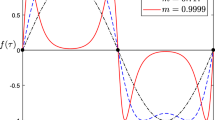Abstract
The computation on a relatively short time of a quantity, related to the largest Lyapunov Characteristic Exponent, called Fast Lyapunov Indicator allows to discriminate between ordered and weak chaotic motion and also, under certain conditions, between resonant and non resonant regular orbits. The aim of this paper is to study numerically the relationship between the Fast Lyapunov Indicator values and the order of periodic orbits. Using the two-dimensional standard map as a model problem we have found that the Fast Lyapunov Indicator increases as the logarithm of the order of periodic orbits up to a given order. For higher order the Fast Lyapunov Indicator grows linearly with the order of the periodic orbits. We provide a simple model to explain the relationship that we have found between the values of the Fast Lyapunov Indicator, the order of the periodic orbits and also the minimum number of iterations needed to obtain the Fast Lyapunov Indicator values.
Similar content being viewed by others
References
Benettin, G., Galgani, L., Giorgilli, A. and Strelcyn, J. M.: 1980, ‘Lyapunov characteristic exponents for smooth dynamical systems; a method for computing all of them’, Meccanica 15: Part I: Theory, 9-20-Part 2: Numerical applications, 21-30.
Chirikov, B. V.: 1960, Plasma Phys. 1, 253.
Contopoulos, G. and Voglis, N.: 1997, ‘A fast method for distinguishing between order and chaotic orbits’, Astron. Astrophys. 317, 73-82.
Froeschl´e, C.: 1970, ‘A numerical study of the stochasticity of dynamical systems with two degrees of freedom’, Astron. Astrophys. 9, 15-23.
Froeschl´e, C.: 1984, ‘The Lyapunov characteristic exponents and applications’, J. de M´ec. th´eor. et apll.Numero sp´ecial, 101-132.
Froeschl´e, C. and Lega, E.: 1998, ‘Twist angles: a fast method for distinguishing islands, tori and weak chaotic orbits. Comparison with other methods of analysis’, AA 334, 355-362.
Froeschl´e, C., Lega, E. and Gonczi, R.: 1997, ‘Fast Lyapunov indicators. Application to asteroidal motion’, Celest. Mech. & Dyn. Astr. 67, 41-62.
Froeschl´e, C. and Lega, E.: 2000, ‘On the structure of symplectic mappings. The Fast Lyapunov indicator: a very sensitive tool’, Celest. Mech. & Dyn. Astr. 78, 167-195.
Froeschl´e, C., Guzzo, M. and Lega, E.: 2000, ‘Graphical evolution of the Arnold's web: from order to chaos’, Science 289-N.5487, 2108-2110.
Greene, J. M.: 1979, ‘A method for determining a stochastic transition’, J. Math. Phys. 20, 1183 pp.
Guzzo, M., Lega, E. and Froeschl´e, C.: 2001, ‘On the numerical detection of the effective stability of chaotic motions in quasi-integrable systems’, (in press).
Laskar, J.: 1993, ‘Frequency analysis for multi-dimensional systems. Global dynamics and diffusion’, Physica D 67, 257-281.
Laskar, J.: 1994, ‘Frequency map analysis of an Hamiltonian system’, Workshop on Non-Linear Dynamics in Particle Accelerators, September 1994, Arcidosso.
Laskar, J., Froeschl´e, C. and Celletti, A.: 1992, ‘The measure of chaos by the numerical analysis of the fundamental frequencies’, Application to the standard mapping’ Physica D 56, 253.
Lega, E. and Froeschl´e, C.: 1997, ‘Fast Lyapunov Indicators. Comparison with other chaos indicators. Application to two and four dimensional maps’, In: J. Henrard and R. Dvorak, (eds) The Dynamical Behaviour of our Planetary System, Kluwer Academic Publishers.
Lega, E. and Froeschl´e, C.: 1996, ‘Numerical investigations of the structure around an invariant KAM torus using the frequency map analysis’, Physica D 95, 97-106.
LeVeque, W. J.: 1977, Fundamentals of Number Theory, Addison-Wesley Publishing Company.
Lichtenberg, A. J. and Lieberman, M. A.: 1983, Regular and Stochastic Motion, Springer, Berlin, Heidelberg, New York.
Locatelli, U., Froeschl´e, C., Lega, E. and Morbidelli, A.: 2000, ‘On the relationship between the Bruno function and the breakdown of invariant tori’, Physica D 139, 48-71.
MacKay, R. S.: 1993, Renormalisation in Area Preserving Maps, World Scientific.
Mahler, K.: 1957, Lectures on Diophantine Approximations.
Morbidelli, A. and Giorgilli, A.: 1995, ‘Superexponential stability of KAM tori’, J. Stat. Phys. 78, 1607 pp.
Nekhoroshev, N. N.: 1977, ‘Exponential estimates of the stability time of near-integrable Hamiltonian systems’, Russ. Math. Surveys 32, 1-65.
Olivera, A. and Sim´o, C.: 1987, ‘An obstruction method for the destruction of invariant curves’, Physica D 26, 181 pp.
Rights and permissions
About this article
Cite this article
Lega, E., Froeschlé, C. on the relationship between fast lyapunov indicator and periodic orbits for symplectic mappings. Celestial Mechanics and Dynamical Astronomy 81, 129–147 (2001). https://doi.org/10.1023/A:1013323507265
Issue Date:
DOI: https://doi.org/10.1023/A:1013323507265




